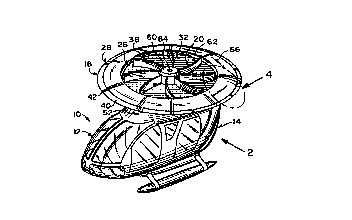Une partie des informations de ce site Web a été fournie par des sources externes. Le gouvernement du Canada n'assume aucune responsabilité concernant la précision, l'actualité ou la fiabilité des informations fournies par les sources externes. Les utilisateurs qui désirent employer cette information devraient consulter directement la source des informations. Le contenu fourni par les sources externes n'est pas assujetti aux exigences sur les langues officielles, la protection des renseignements personnels et l'accessibilité.
L'apparition de différences dans le texte et l'image des Revendications et de l'Abrégé dépend du moment auquel le document est publié. Les textes des Revendications et de l'Abrégé sont affichés :
| (12) Demande de brevet: | (11) CA 2199278 |
|---|---|
| (54) Titre français: | AERONEF A AILES CIRCULAIRES |
| (54) Titre anglais: | CIRCULAR WING AIRCRAFT |
| Statut: | Réputée abandonnée et au-delà du délai pour le rétablissement - en attente de la réponse à l’avis de communication rejetée |
| (51) Classification internationale des brevets (CIB): |
|
|---|---|
| (72) Inventeurs : |
|
| (73) Titulaires : |
|
| (71) Demandeurs : |
|
| (74) Agent: | OSLER, HOSKIN & HARCOURT LLP |
| (74) Co-agent: | |
| (45) Délivré: | |
| (86) Date de dépôt PCT: | 1995-09-05 |
| (87) Mise à la disponibilité du public: | 1996-03-14 |
| Requête d'examen: | 1998-09-02 |
| Licence disponible: | S.O. |
| Cédé au domaine public: | S.O. |
| (25) Langue des documents déposés: | Anglais |
| Traité de coopération en matière de brevets (PCT): | Oui |
|---|---|
| (86) Numéro de la demande PCT: | PCT/US1995/011203 |
| (87) Numéro de publication internationale PCT: | WO 1996007586 |
| (85) Entrée nationale: | 1997-03-05 |
| (30) Données de priorité de la demande: | ||||||
|---|---|---|---|---|---|---|
|
L'invention se rapporte à un aéronef à ailes circulaires (10) se présentant sous forme d'un hélicoptère (12) comprenant un fuselage (14) et un ensemble aile circulaire (16). Une structure (18) permet la fixation de l'ensemble aile circulaire (16) au-dessus du fuselage (14). Une roue à aubes pneumatique (20) est montée rotative à l'intérieur de l'ensemble aile circulaire (16). Un dispositif (22) est destiné à entraîner la roue à aubes pneumatique (20) pour qu'elle tourne autour d'un axe central (24) à l'intérieur de l'ensemble aile circulaire (16), de manière à assurer la sustentation et le déplacement en vol tout en maintenant le contrôle en lacet.
A circular wing aircraft (10) in the form of a helicopter (12) comprising a
fuselage (14) and a circular wing assembly (16). A structure (18) is for
mounting the circular wing assembly (16) above the fuselage (14) in a
stationary manner. An air impeller unit (20) is rotatively carried within the
circular wing assembly (16). A device (22) is for driving the air impeller
unit (20) to rotate about a central axis (24) within the circular wing
assembly (16), so as to provide lift and flight movement while yaw control is
maintained.
Note : Les revendications sont présentées dans la langue officielle dans laquelle elles ont été soumises.
Note : Les descriptions sont présentées dans la langue officielle dans laquelle elles ont été soumises.

2024-08-01 : Dans le cadre de la transition vers les Brevets de nouvelle génération (BNG), la base de données sur les brevets canadiens (BDBC) contient désormais un Historique d'événement plus détaillé, qui reproduit le Journal des événements de notre nouvelle solution interne.
Veuillez noter que les événements débutant par « Inactive : » se réfèrent à des événements qui ne sont plus utilisés dans notre nouvelle solution interne.
Pour une meilleure compréhension de l'état de la demande ou brevet qui figure sur cette page, la rubrique Mise en garde , et les descriptions de Brevet , Historique d'événement , Taxes périodiques et Historique des paiements devraient être consultées.
| Description | Date |
|---|---|
| Inactive : Regroupement d'agents | 2013-10-24 |
| Demande non rétablie avant l'échéance | 2001-09-05 |
| Le délai pour l'annulation est expiré | 2001-09-05 |
| Réputée abandonnée - omission de répondre à un avis sur les taxes pour le maintien en état | 2000-09-05 |
| Inactive : Acc. réc. RE - Pas de dem. doc. d'antériorité | 1998-12-07 |
| Requête d'examen reçue | 1998-09-02 |
| Toutes les exigences pour l'examen - jugée conforme | 1998-09-02 |
| Exigences pour une requête d'examen - jugée conforme | 1998-09-02 |
| Inactive : Notice - Entrée phase nat. - Pas de RE | 1997-08-25 |
| Inactive : CIB attribuée | 1997-08-07 |
| Inactive : CIB en 1re position | 1997-08-07 |
| Inactive : CIB attribuée | 1997-08-07 |
| Inactive : Correction au certificat de dépôt | 1997-06-12 |
| Exigences de dépôt - jugé conforme | 1997-06-12 |
| Demande publiée (accessible au public) | 1996-03-14 |
| Date d'abandonnement | Raison | Date de rétablissement |
|---|---|---|
| 2000-09-05 |
Le dernier paiement a été reçu le 1999-09-03
Avis : Si le paiement en totalité n'a pas été reçu au plus tard à la date indiquée, une taxe supplémentaire peut être imposée, soit une des taxes suivantes :
Veuillez vous référer à la page web des taxes sur les brevets de l'OPIC pour voir tous les montants actuels des taxes.
| Type de taxes | Anniversaire | Échéance | Date payée |
|---|---|---|---|
| Taxe nationale de base - petite | 1997-03-05 | ||
| TM (demande, 2e anniv.) - petite | 02 | 1997-09-05 | 1997-09-03 |
| TM (demande, 3e anniv.) - petite | 03 | 1998-09-08 | 1998-09-02 |
| Requête d'examen - petite | 1998-09-02 | ||
| TM (demande, 4e anniv.) - petite | 04 | 1999-09-07 | 1999-09-03 |
Les titulaires actuels et antérieures au dossier sont affichés en ordre alphabétique.
| Titulaires actuels au dossier |
|---|
| GABOR I. VASS |
| Titulaires antérieures au dossier |
|---|
| S.O. |